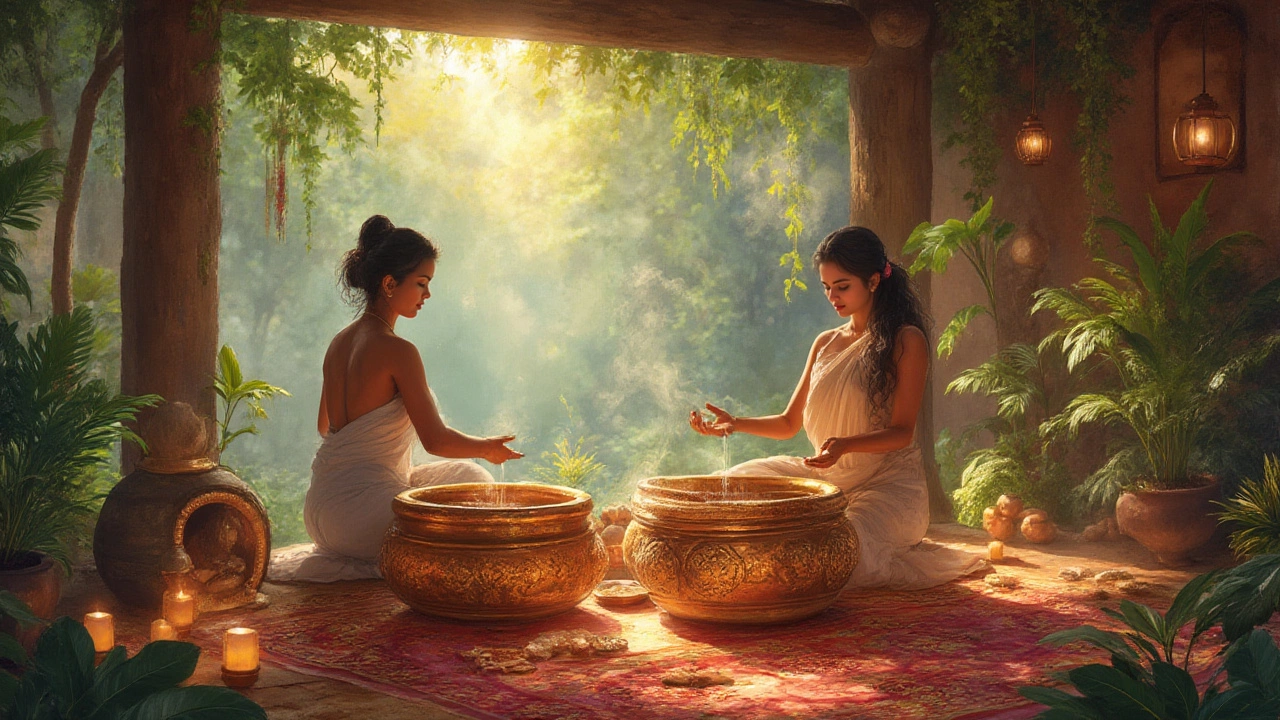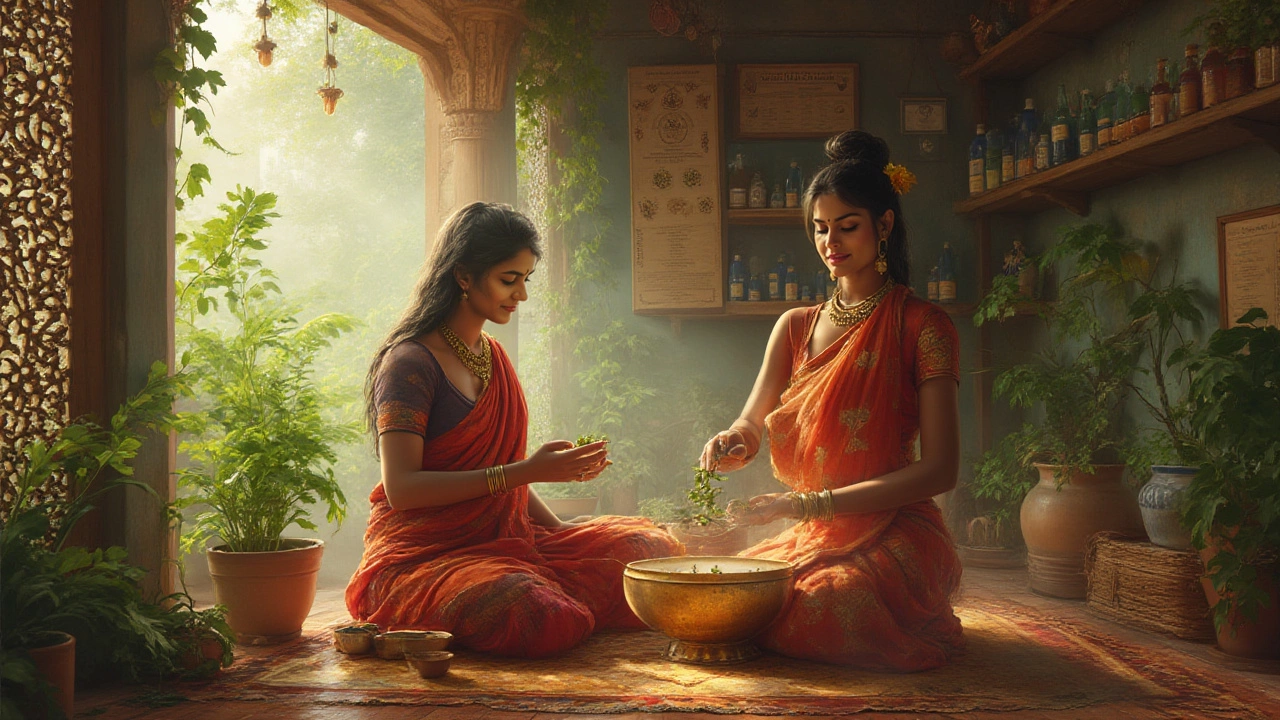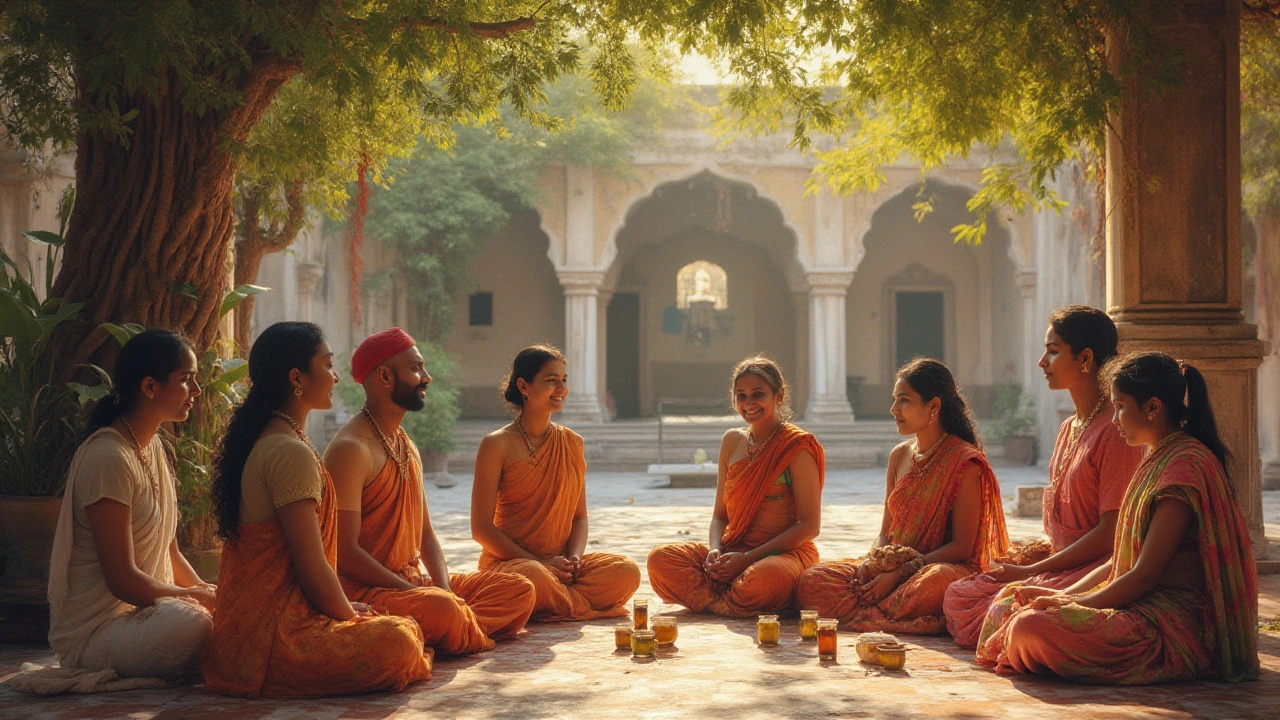Ayurvedic Massage: Traditional Healing Techniques for Modern Wellness
 Jul, 22 2025
Jul, 22 2025
If someone said a simple touch could help reset your mind and fix nagging aches, would you believe them? Ayurvedic massage isn’t about empty promises or spa-day fluff. It’s ancient, yes, but the punch it packs for your body and brain is everything but outdated. Imagine someone pouring warm, herbal oil on your back, working it in with hands practiced for years, not just relaxing muscles, but getting to the root of what’s off-kilter inside you. This is no regular rubdown. It’s part art, part science—something people in India have done for more than 3,000 years, and as weird as it sounds, it’s still shaping how we think about feeling better today.
The Roots and Philosophy of Ayurvedic Massage
Ayurvedic massage, often called Abhyanga, sits smack in the middle of Ayurveda, India’s holistic health science. People sometimes confuse it with any oil massage, but it’s not just about oil and touch—it’s more like reading your body’s secret language. To get what makes Ayurvedic massage unique, you have to understand doshas: Vata, Pitta, and Kapha. Think of doshas like your body’s blueprint. Every person’s mix is different, so therapists adjust everything—oil, touch, direction, even timing—to match your needs on that day. It isn’t a one-size-fits-all thing; in fact, a seasoned practitioner might take your pulse, check your tongue, and chat about your sleep, digestion, and moods before touching a drop of oil.
This isn’t just some modern-day revival. Ayurvedic texts going back to the Charaka Samhita (written before the Roman Empire) describe detailed bodywork methods. What’s wild is that even now, many doctors in India prescribe Ayurvedic massage alongside pills or yoga. They see it as a tool that resets the whole system, not just treating sore muscles but also sleeplessness, poor digestion, stress, and even heart health. Back in the day, kings and monks would book daily Abhyanga, believing it could add years to their life. There’s also a big social side to it – Indian families often give newborns, athletes, and elders regular massage, betting on prevention instead of cure.
Fast-forward to today, and scientists are starting to peek at the reasons these traditions stuck around. A small but growing pile of research says that Ayurvedic massage, especially Abhyanga, may help calm the stress hormone cortisol, improve blood flow, and soothe nerves better than some Western methods. A 2021 clinical study in India found that weekly Abhyanga improved sleep quality and joint flexibility for people over age 50. Another review in the Journal of Alternative and Complementary Medicine reported lower anxiety in people getting regular Ayurvedic oil massage, especially compared to standard Swedish techniques. The idea here is not just physical changes. Ayurvedic philosophy says you’re balancing prana—life energy. Does that sound mystical? Maybe, but anyone who’s felt their mind go quiet as warm oil slides down their spine can tell you, there’s something surprisingly centering about it.
Important tip: real Ayurvedic massage isn’t about deep-tissue bruising or hard-as-rock pressure. It’s rhythmic, deeply intentional, and tied to your dosha pattern for that day, season, or life stage. Therapists use hands, elbows, even feet sometimes, following precise patterns along the body’s marma points (similar to acupuncture points). The idea is to clear blocked energy without causing pain. The quality of the oil matters as much as the movements—some recipes contain more than a dozen herbs cooked slowly into sesame or coconut oil, tailored for what your body needs most.

Techniques, Oils, and Types of Ayurvedic Massage
Not every Ayurvedic massage looks or feels the same. The technique changes based on your dosha mix, age, time of year, and even the time of day. The most famous is Abhyanga—usually a full-body treatment, with both therapist and client covered in warm oil (think sesame for vata types, coconut for pitta, and mustard for kapha). Done right, Abhyanga should last at least 45 minutes, with steady strokes that match the direction of hair growth, meant to wake up the lymph system and sweep out old toxins.
But Abhyanga doesn’t own the spotlight. Other types include Shirodhara (where oil streams steadily across your forehead like warm rain, a favorite for folks with stress or insomnia), and Udvartana (where fine herbal powders replace oil, great for oily skin or anyone keen on cellulite-busting and exfoliation). Pizhichil combines hot oil pouring with massage—imagine a gentle rainfall of nourishing oil across your whole body, which some clinics use for nerve or muscle problems. Marma point therapy focuses on energy centers, a bit like acupressure, targeting one or two crucial knots that seem to clog up energy. Each method feels noticeably different, and therapists might switch styles mid-session if your body starts to respond in unexpected ways. Ayurveda says that’s the whole point—stay flexible, tune in.
Oils are a science in themselves. The classic base is sesame oil, popular because it penetrates the skin easily and is believed to balance vata (which governs anxiety, dryness, and age). Coconut oil, cooling and gentle, works for people whose pitta gets out of whack—think irritated skin or hot tempers. Mustard oil, spicy and warming, wakes up sluggish kapha types and helps on winter days. Then come the custom blends: Ashwagandha for strength, Brahmi for nerves, Neem for skin fixes, Bala for stamina, and more. Some Ayurvedic pharmacies in Kerala or Goa sell oils steeped with over twenty herbs, slow-cooked for days. Home therapists might even make their own, adjusting the recipe each season.
Most sessions start with a dose of warm oil—sometimes up to half a cup or more, massaged in long strokes from head to toe, always moving toward the heart to help detox. Movements are always slow, often synchronized with your breath. Therapists might spend extra time on the scalp if you complain of headaches, or focus on the stomach for those with weak digestion or stress eating. In traditional clinics, they’ll wrap you in a warm towel afterward to help the oil sink in, or use herbal steam to unlock stiff joints—the choices are endless. People flock to these treatments for so many reasons: older adults with creaky knees, athletes with sore backs, new moms needing recovery, even busy city folks burnt out from screen life. The real secret? What you get isn’t just skin-deep. Ayurveda believes every tissue soaks up the benefits, right down to your nerves, your muscles, even your immunity.
If you’re booking an Ayurvedic massage, don’t expect someone to hand you a standard brochure. Every session should start with a quick check-in (sometimes called “prakruti” and “vikruti” check), making sure the oils and technique match your mood, energy, and body’s needs. Some Ayurvedic clinics will even tweak the length or style of massage if it’s humid or dry outside. Trying your first Abhyanga at home? Warm your oil in a bowl of hot water, lock the bathroom door, and rub your skin in steady, loving strokes—start at the head and work downward. Let the oil sit for at least 20 minutes if you can, then rinse with warm water. Even once or twice a week can make a difference.

Ayurvedic Massage: Benefits and Modern Tips for Making It Work for You
So what’s actually happening under your skin during an Ayurvedic massage? First off, there’s the physical: slow, gliding strokes wake up the lymphatic system, nudging toxins out the door instead of letting them build up and bog you down. The oils soak deeply into the outer layers of skin, giving your skin a serious quench—bonus points for people who battle dry, flaky patches or eczema. Because Ayurveda says massage nourishes all the dhatus (body tissues), it’s recommended for athletes, kids with growing pains, even people healing from long illnesses. A 2022 controlled study in southern India found that daily Abhyanga for two weeks improved joint flexibility for people with mild arthritis better than standard pain lotions.
But there’s more than just muscle perks. If anxiety or monkey mind keeps you up at night, science backs what Ayurveda’s claimed for centuries: rhythmically massaging the body calms the central nervous system. Lab tests show oil massage can lower cortisol (the stress hormone) and boost serotonin, which keeps moods steady. Therapists from big hospitals in India report that even cancer patients, when paired with Ayurvedic massage, recover faster from chemotherapy fatigue. On top of this, a lot of people say their digestion gets a welcome reset; some Ayurvedic clinics will spend extra time circling the belly for folks who always feel bloated or gassy.
Tips for making the most of it? Choose your oils based on the season and your stress level. Go for sesame oil in winter or dry, windy seasons. Try coconut oil if you run hot or get skin rashes easily. Buy your oils pure—skip supermarket brands with added fragrance or mineral oil. After your session, let the oil soak in for as long as life allows, then rinse off gently. Don’t use cold water, or you’ll undo everything relaxing your body just did. Also, expect to feel a little sleepy or out-of-it right after; plan to chill, not rush off to a meeting. If you’re new, start with at least once a week, and go up based on how your body feels. People with certain health issues—pregnancy, recent surgery, skin infections—should always check with a professional before booking a session.
Ayurvedic massage isn’t meant to replace medical care for serious conditions. But as a reset button for aches, anxiety, sluggishness, and even bad mood, it has a surprisingly powerful track record. The hands-on experience connects you to your own body’s rhythms in a way stretching or pills can’t. Think of it as a blend of pampering and preventative medicine—something ancient, but somehow more relevant than ever on stressful days. Try it once, keep an open mind, and see how your body surprises you. Chances are, you’ll walk out not just lighter in step, but more present and in tune with yourself—something most of us are chasing, now more than ever.